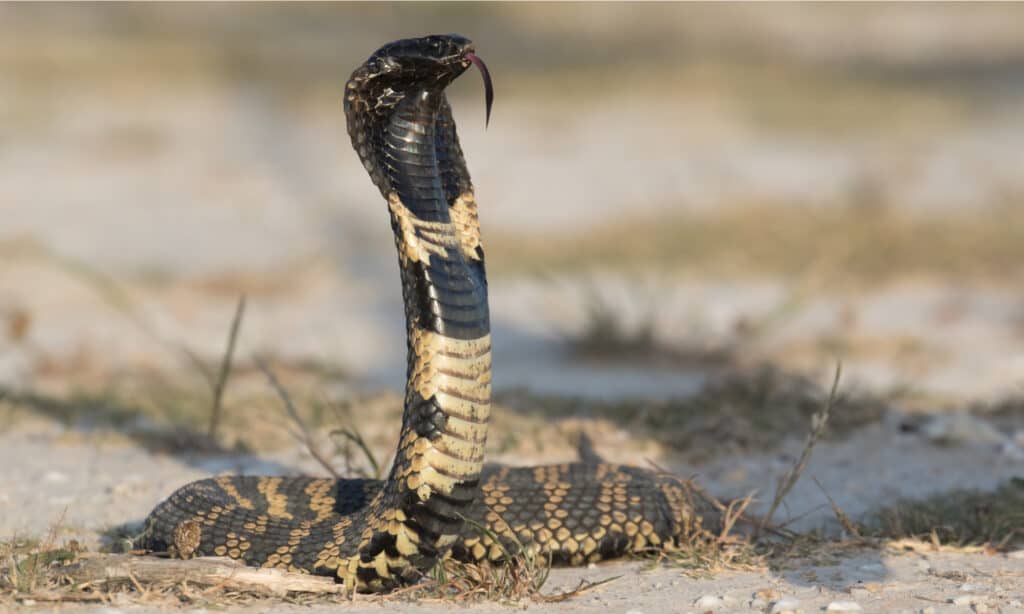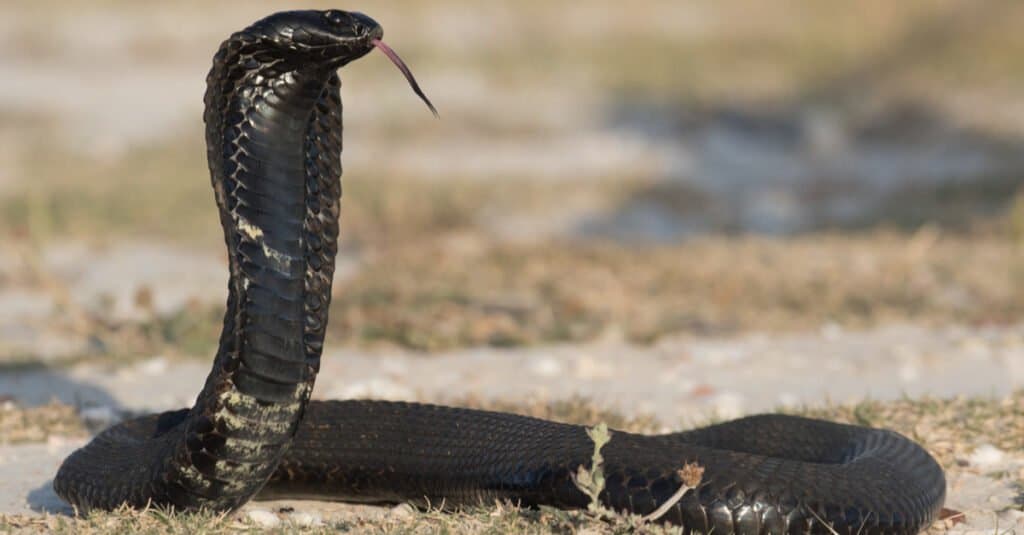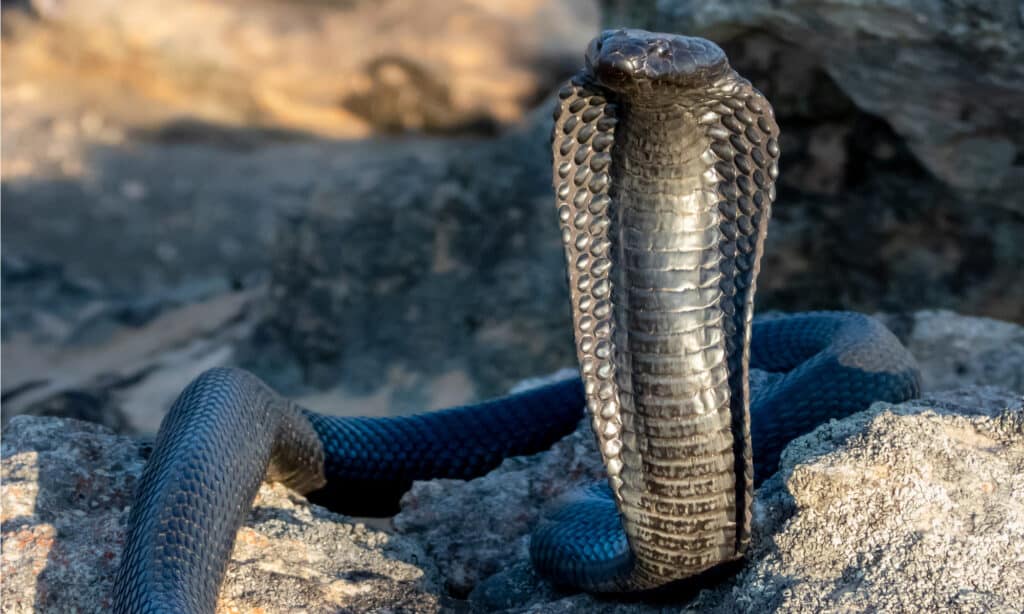Knowing a snake has made its way onto your property is one thing, but knowing that the snake that is hanging around your home is a cobra is another thing entirely, especially if you have kids! This viral video shows just how dangerous and angry a snake can be when pushed out of its home. In this case, the snake is a cobra in a gutter.
Check Out the Video Below!
The video starts with a standard camera shot of a pipe threaded under a concrete sidewalk. However, a lot more action will soon happen! You can hear water run, with the idea to push the snake out of the pipe so for safe removal.
As the water level rose in the pipe, a large and angry Rinkhals cobra popped out from the opening like a venomous jack-in-the-box! What ended up emerging from the tube was a Rinkhals, a highly venomous snake that can spit its venom up to nearly 10 feet away.
It also has a distinctive defense posture, where it raises its head and neck and spreads its hood. The other common name for these snakes is “spitting cobra” or sometimes a “ring-necked cobra”, although they technically aren’t considered true members of the cobra family.
Regardless of how it was scientifically classified, the cobra in the gutter was not happy to be disturbed. It hissed loudly and lunged at the man who had approached from behind in order to grab it. With a deft movement, the professional snake wrangler saw an opening and took it. Quickly moving behind the snake, he grabbed it with his special tool, making sure that the neighborhood was safe from the dangerous reptile!
Rinkhals, a Venomous Spitting Snake

Rinkals are often called spitting cobras.
©Andre Coetzer/Shutterstock.com
The Rinkhals cobra is a venomous snake that lives in parts of South Africa, where this video was recorded. Despite what people refer to it as a cobra, it’s not actually a true cobra. Instead, the Rinkhals cobra belongs to a different genus called Hemachatus.
It features a dark belly with one or two light-colored bands on the throat and may have a body with stripes or spots. Incredibly, it can spit its venom and spread its hood when threatened (as can be seen throughout the clip). It feeds mainly on toads but also eats small mammals, amphibians, and other reptiles.
How Do You Transport Venomous Snakes?

The venom from a Rinkhals snake is extremely dangerous, whether injected via fangs or through spitting into an offender’s eyes.
©Andre Coetzer/Shutterstock.com
Professional snake handlers are experts who know how to safely capture and transport snakes, especially venomous ones. They use special equipment such as hooks, tongs, tubes, bags, and boxes to handle the snakes without harming them or themselves. In the video, you can see one of these tools used to safely grab the snake without hurting it. The handler is also careful not to allow it to get near the person trying to help relocate it.
They also wear protective clothing such as gloves, boots, and goggles to prevent bites and venom spray. Although not all of these were used to catch the Rinkhals, you can see the handler wearing protective eye gear in order to avoid getting venom in his eyes! Be sure you trust a professional if you ever come across a cobra in a gutter!
How Large Does a Spitting Cobra Get?

The black-necked spitting cobra (Naja nigricollis) is a spitting cobra species predominantly located in sub-Saharan
Africa
.
©Willem Van Zyl/Shutterstock.com
The black-necked spitting cobra (Naja nigricollis) is a spitting cobra species primarily found in sub-Saharan Africa. These snakes are of moderate size, typically ranging from 3.9 to 7.2 feet in length.
The largest spitting cobra, on average, measures approximately 4.3 to 6.6 feet in total length, including the tail. The largest recorded specimen of this species, captured in Kenya, reached an impressive 8.9 feet in total length.
Furthermore, red spitting cobras exhibit a mild level of aggression towards both humans and their prey. This aggressiveness primarily stems from the snake’s remarkable ability to cleverly target even large creatures, such as humans, by projecting venom up to a distance of 8 feet, aiming for their eyes.
Is It Normal for Spitting Cobras to Attack Humans?
Spitting cobras like the Rinhals variety are not overtly aggressive. They would prefer to avoid encounters with humans, but if they feel threatened, they will stand erect, hiss, and possibly spit venom as a form of defense. It’s not unusual to encounter one in suburban areas if the environment tempts one to settle down. They prefer hiding places like holes, brush piles, wood piles, termite mounds, or other places they could go undetected (like gutters, as seen in the video).
The Rinkhals spitting cobra’s weapon of choice is its venom, but it delivers it through spitting more than through biting. Their cytotoxic venom, which they can spit up to 2 1/2 meters in distance, generally doesn’t hurt human skin, though it can cause blistering. The main area of the body to worry about is the eyes, as the venom can do severe damage if left untreated. They purposely aim for the face and eyes, and if hit, can suffer severe pain, tearing, or photophobia in the eyes. A corneal ulcer or keratitis is possible, and some victims have gone blind.
The most dangerous cobra, the king cobra, is only responsible for around 5 deaths a year. Many more deaths occur annually in North America from rattlesnake bites than cobras in their native countries.
The photo featured at the top of this post is © Eugene Troskie/Shutterstock.com
Discover the "Monster" Snake 5X Bigger than an Anaconda
Every day A-Z Animals sends out some of the most incredible facts in the world from our free newsletter. Want to discover the 10 most beautiful snakes in the world, a "snake island" where you're never more than 3 feet from danger, or a "monster" snake 5X larger than an anaconda? Then sign up right now and you'll start receiving our daily newsletter absolutely free.
Thank you for reading! Have some feedback for us? Contact the AZ Animals editorial team.






